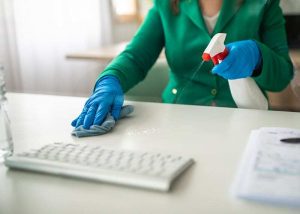How Can We Help?
What are the CDC Updates About (Not?) Cleaning Surfaces to Protect Against COVID?

The CDC updated it’s guidance around cleaning surfaces with regards to COVID transmission. We know that the coronavirus spread and infection through “fomite” surface contact is very low compared to airborne and droplet transmission. The recent announcement offers new specifics, as there is “little scientific support” for routine disinfectant use to prevent surface contact infection.
Early in the pandemic this was not as clear and resulted in aggressive disinfection with bleach and sprays and wipes. Empty grocery store shelves in the home cleanup aisles became a common sight, with sales quickly spiking as people grabbed as much of the coveted disinfectants as they could. The president of Clorox reported that the company saw an incredible 500% spike in demand versus the year before.
However, the current guidance says routine cleaning with soap (or detergent) and water – not disinfectant – in your home is sufficient to clean indoor surfaces and lower the risk of spreading the coronavirus. High-touch surfaces should be cleaned once a day, and more frequency cleaning may be needed if the space is occupied by young children and others who may not consistently wear masks, wash their hands, or cover their coughs and sneezes. Disinfection is only recommended in indoor settings, school, and homes where there has been a suspected or confirmed case of COVID-19 within the last 24 hours. For communal spaces, routine disinfecting is advised since there is still community spread of the virus. Wear gloves for all tasks in the cleaning process, and wash your hand with soap and water for 20 seconds after cleaning.
Dr. Walensky of the CDC, urges “wearing masks consistently and correctly, washing your hands, and following health experts’ guidance to maintain healthy facilities can help reduce the risk of surface transmission. The main way people are infected with COVID-19 has been close, person-to-person contact.”
Prerana Sangani, MD, April 12, 2021


